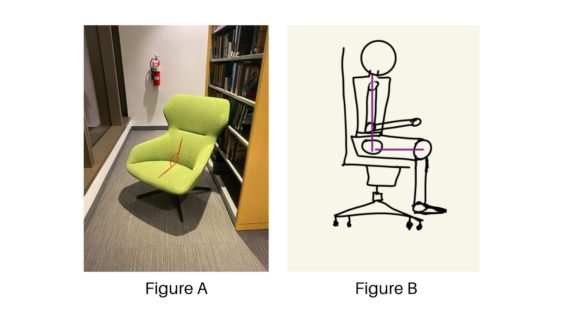Please, I beg of you, listen up.
The Milstein Green Chairs. An iconic staple of Barnard. Soft, cushiony, and a stunning shade of green, these chairs are greatly coveted on our lovely campus. I even have a green chair sticker! Little did I know that these chairs, along with the other deceptive chairs of Barnard, would cause me severe heartbreak, betrayal, and most of all, back pain.
Last Tuesday, I woke up with shooting pains all throughout my back. Should I have seen a doctor? Probably. But that was too scary (I was not about to do adult things), so I grabbed my handy dandy ice pack and was off on my day. As the day and week progressed, the pain just got worse and worse (also compounded by my Orchesis tech week shoutout Orchesis). I was struck. What was causing me such pain? How had my life taken such a drastic turn, with every waking hour consumed by the piercing jabbing in my back? Sitting back in a Milstein green chair, I had an epiphany.
It was just that. The green chairs.
I had spent precisely seven hours in a row Monday afternoon and night in a green chair. Maybe it was that very chair that did an initial rupturing of my back (metaphorically, of course). Here’s where I decided to dive into the research.
Woman In STEM moment—proceed at your own risk.
If you take a look at Figure A, a lovely picture of the exact chair that broke my back (far right, Milstein 3, feel free to send it hate mail), it is clear that there is no way to sit in the chair with good posture or back support. According to the highly factual, peer-reviewed, cutting-edge scientific source (satire alert satire alert satire alert) of these drawings created by Bwog, the correct posture for back support involves a completely upright back, with just about a 90º angle made with the legs (see Figure B). I’m no math major, but the angle made by the green chairs is hella obtuse, making this ideal back positioning impossible.

In fact, if you direct your attention to Figures C and D, other chairs with “hella obtuse” angles, these back positioning images are examples of chairs not to sit in. These reclining chairs, according to Physiomed, “put more pressure on the neck, shoulders and arms, restricting torso movement and causing pain” and “increase the pressure on your spine.” Thus, my mathematical proof is complete—Barnard’s chairs were what did it for my poor, poor back.

You thought that was it, didn’t you. Just you wait—there’s more! Upon this life-shattering realization that these green chairs were out to get me, I was off to find chairs with better back support. I knew I could find myself a place to study in peace, without the ever-present feeling of pins and needles running down the entirety of my back. And guess what?!? Every. Chair. Was. The. Same. Way.
Let me repeat that.
Every Chair. On Barnard’s Campus. Is Out. To. Get. You.
The red chairs on the fifth floor of Diana? Check. The silly little wheely chairs in my Barnard Hall seminar room? Check. The relaxing chairs at Liz’s place? Check. The comfy chairs in the Brooks Study Lounge? Check.
This should concern you. This should give you chills up and down your spine (lol). This is terrifying. Why are our chairs disguised in bright colors and comfy fabrics as a RUSE for breaking our backs? Why is Barnard coming after our backs? How is no one speaking out on this topic? How did it get to this point? WHY DOES MY BACK HURT SO MUCH?
*Deep breath*
I mean to cause no harm. I simply am looking for answers. And Advil. And any back remedies you may have.
Please contact me with any updates on chairs and backs you may have. And, to all Barnumbia students, PLEASE stay safe out there. Think critically about the chairs you choose to sit in. Watch your back.
Chair Collages via Bwog Staff
Proper Sitting Technique Images via Bwog Staff


 4 Comments
4 Comments
4 Comments
@Anonymous Fascinating read. I do wounder though if every chair on Barnard campus is so detrimental to the back, then every student who sits would experience this pain! As this is not the case, I believe you are falsely attributing your problem on external factors. Be very careful in spreading misinformation. #sparethechairs
@Anonymous please no this is devastating bc i love these so much. do you have recs for libraries w ideal seating?
@Emma Burris i love these diagrams so so much
@Sophie Conrad thank you I worked very hard on them